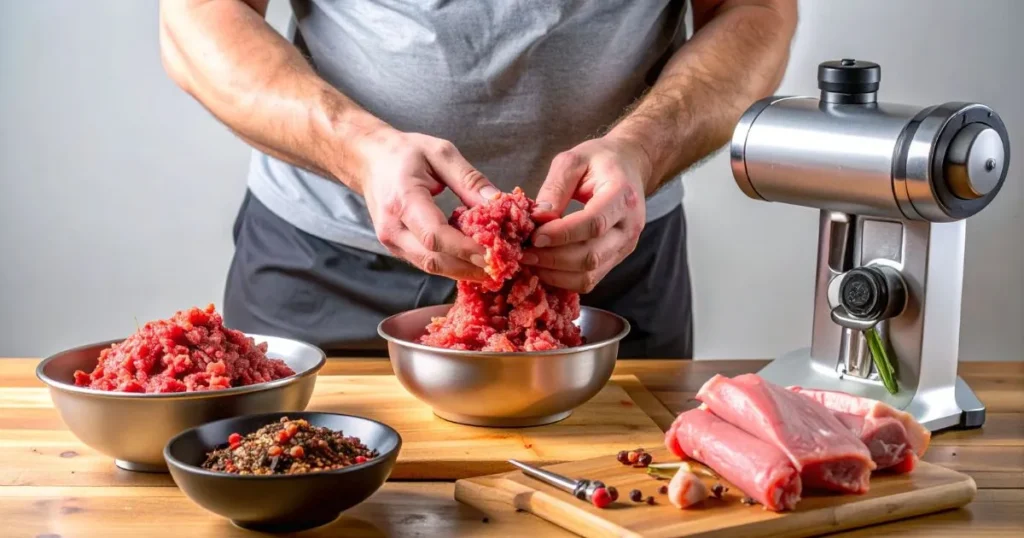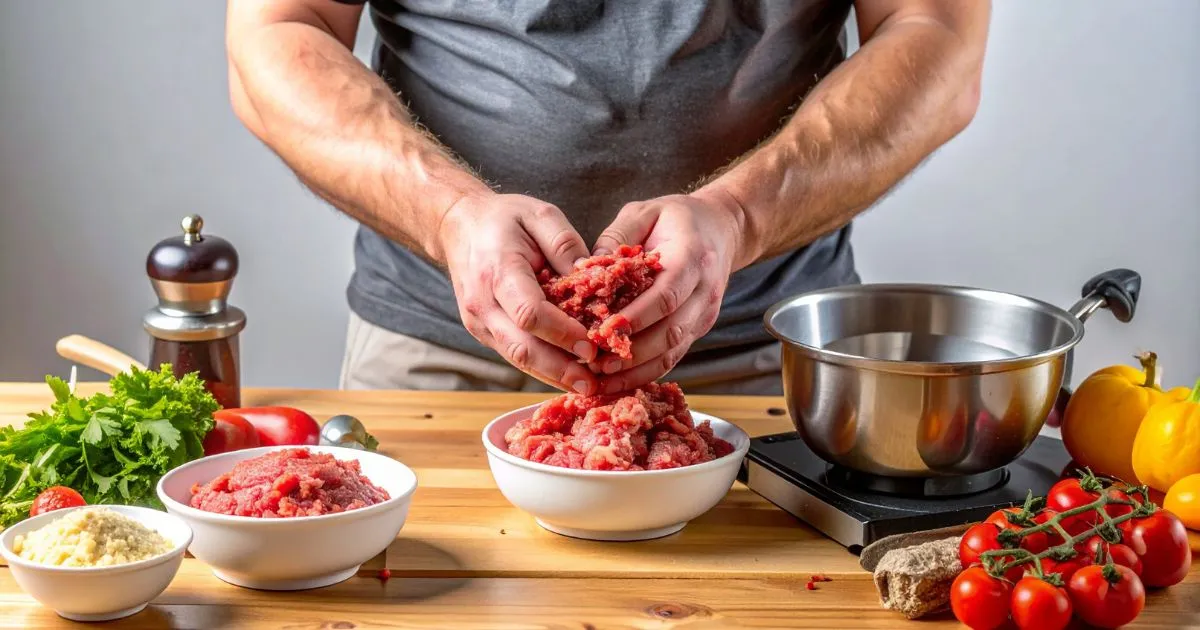Table of Contents
Deer sausage from scratch:
More Than Just Meat – A Tradition in Every Bite
You know that moment of pride when you harvest a deer after hours of patience in the stand? That feeling of satisfaction follows you long after the hunt is over. It continues in the kitchen. Making deer sausage from scratch isn’t just about preserving meat – it’s about preserving tradition. Whether this is your first time or your fiftieth, you’ll find that the process connects you with your food, your roots, and the people you share it with. Let’s walk through each step so you can turn your venison into a sausage worth savoring.
What You Need Before You Begin: Tools and Ingredients for Homemade Deer Sausage
Before diving in, you need to gather the right tools and ingredients. Preparation is key to making sausage that tastes great and holds up well.
Essential Tools for Sausage Making
- Meat grinder (manual or electric)
- Sausage stuffer or a stuffing attachment
- Sharp knives for trimming
- Large mixing bowls for combining ingredients
- Digital scale to measure meat-to-fat ratios
- Thermometer (important for cooking or smoking)
- Natural or synthetic casings (depends on your preference)

Ingredients Overview
Here’s a quick breakdown of what you’ll need:
| Ingredient | Amount | Notes |
|---|---|---|
| Ground venison | 5 lbs | Trim all sinew and silver skin |
| Pork fat or pork shoulder | 2-3 lbs | Adds vital moisture and flavor |
| Garlic (minced) | 2-3 cloves | Adds aromatic depth |
| Salt | 2 tbsp per 5 lbs meat | Use curing or kosher salt |
| Spices (custom blend) | As preferred | Paprika, pepper, fennel, etc. |
| Ice water | 1 cup | Helps with mixing and protein binding |
Step-by-Step: How to Make Deer Sausage from Scratch
Each step in the sausage-making process plays a crucial role. Pay close attention to each step to ensure your sausage turns out just right.
Step 1 – Prepping the Meat
- Remove any tough membranes or connective tissue from the venison.
- Cut the venison and pork fat into small, uniform chunks.
- Keep the meat very cold—nearly frozen—to help maintain its structure when grinding.
Step 2 – Grinding the Meat
- Start by grinding your venison and fat using a coarse disc.
- If you want a finer blend, run the ground meat through the grinder a second time with a smaller plate.
- Keep meat cold throughout the process to maintain texture and safety.
Step 3 – Seasoning and Mixing
- Measure spices and salt based on your desired flavor profile.
- Sprinkle seasonings evenly over the meat.
- Add a cup of ice water to help with protein extraction.
- Mix thoroughly until the mixture becomes tacky – that’s the myosin activating.
Step 4 – Stuffing the Sausage
- Soak your natural casings in warm water for 30 minutes.
- Flush the inside of each casing to remove excess salt.
- Set up your stuffer and fill it carefully with your seasoned meat blend.
- Carefully stuff casings, making sure to remove air pockets.
- Twist into links or tie with butcher’s twine at desired lengths.
Step 5 – Cooking or Smoking the Sausage
- Fresh Sausage: Cook to an internal temperature of 160°F by pan-frying, baking, or grilling.
- Smoked Sausage:
- Air-dry for 1-2 hours.
- Smoke at 140-160°F until internal temp reaches 155-160°F.
- Let cool before refrigerating or freezing.

Flavor Variations: Make It Your Own
You can tailor your deer sausage to suit your personal taste or regional favorites.
Popular Deer Sausage Flavor Profiles
- Spicy Italian: Fennel, crushed red pepper, garlic, paprika.
- Breakfast Style: Sage, black pepper, thyme, maple syrup.
- Jalapeño Cheddar: Fresh jalapeños and shredded sharp cheddar.
Tips for Experimenting with Spices
- Always start small – you can add more, but you can’t take it out.
- Fry a small patty to taste-test your seasoning before stuffing.
- Keep notes on each batch for future reference.
Storing and Preserving Your Deer Sausage
Keeping your sausage stored the right way helps protect all the effort you put in.
Refrigeration vs. Freezing
- Keep raw sausage in a sealed container in the fridge for no more than three days.
- Freeze: Vacuum-seal and store for up to 6 months for best quality.
Curing and Drying
- If making cured sausage (like salami), follow proper USDA guidelines.
- If you’re making cured sausage, include a curing salt such as Prague Powder #1 for safety and preservation.
- Maintain specific humidity and temperature conditions.
Common Mistakes to Avoid When Making Deer Sausage
Pitfalls to Watch For
- Too little fat: Leads to dry, crumbly sausage. Always aim for at least 25-30% fat.
- Mixing too aggressively can make your sausage firm and rubber-like.
- Under-seasoning: Venison has a strong flavor, so don’t be afraid to use bold spices.
- Air pockets: These can spoil your sausages. Use a needle or pin to let any air escape from the casing.
Frequently Asked Questions (FAQ) About Making Deer Sausage
What’s the ideal balance of fat and lean meat in deer sausage?
You’ll get the best results using a 70/30 ratio of venison to pork fat. This ensures moisture, flavor, and the classic sausage snap.
Can I make deer sausage without pork?
Yes, you can substitute with beef fat or duck fat, but texture and flavor will vary. Just maintain the 30% fat content.
Do I need special equipment to make deer sausage from scratch?
While a grinder and stuffer make the job easier, small batches can be made with hand tools and elbow grease. Be ready to put in a bit more elbow grease if you’re going the manual route.
How long does homemade deer sausage last?
Refrigerated fresh sausage lasts 3 days. Frozen sausage can be stored up to 6 months. Smoked and properly cured sausage can last even longer.
Can I make deer sausage spicy?
Absolutely. Customize your spice blend with cayenne, red pepper flakes, or hot paprika to match your heat preference.

From Field to Fork – The Joy of Homemade Deer Sausage
Making your own deer sausage from scratch is more than a skill – it’s a deeply personal way to enjoy the harvest. You get to decide exactly what goes into it, how it tastes, and how it’s made. It’s cost-effective, satisfying, and a great way to share something meaningful with family and friends.
Don’t let that venison sit in the freezer waiting for a random stew. Put it to good use. Fire up the grinder, get your hands a little messy, and create something unforgettable.
Ready to try it yourself?
Tag a buddy, share this guide, and start your own sausage-making tradition. Your next hunting season will taste even better.

